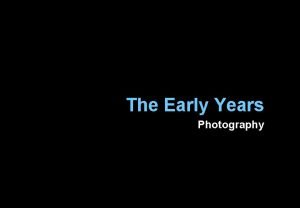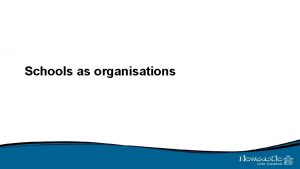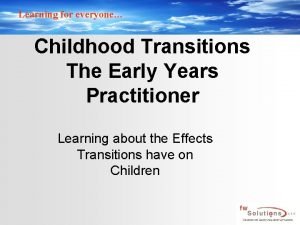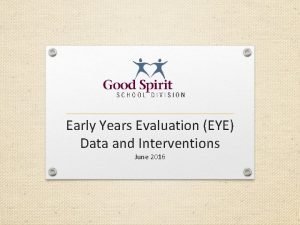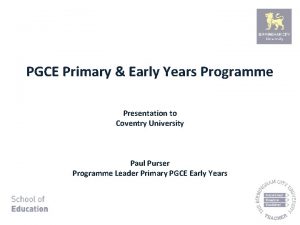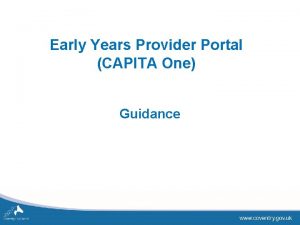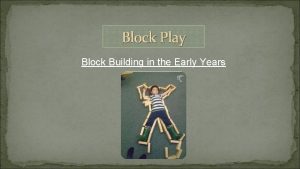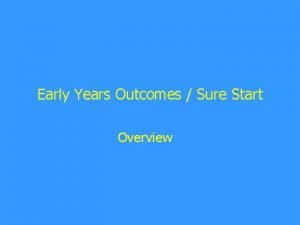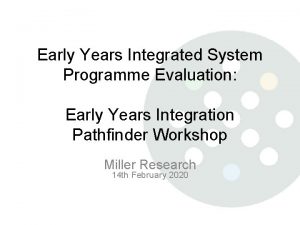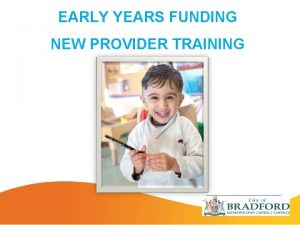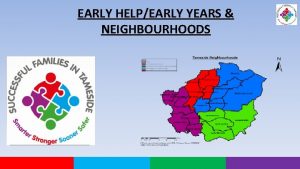Counting the cost of funded early years education


















- Slides: 18

Counting the cost of funded early years education and childcare Presented by Dr Jo Verrill Managing Director, Ceeda

Our aim The Pre-school Learning Alliance commissioned the study to answer some fundamental questions • What does it cost to deliver an hour of quality early education and childcare? • How much is paid for this hour of quality early education and childcare? • What is the difference between the delivery cost and funding rate?

The knowledge gap Elements contributing to group based provider costs 2% 1%1%1% 3% 2% 7% 7% 77% Staff costs Rent/mortgage Materials Admin Utilities Maintenance Rates Insurance Interest Can’t translate to hourly cost Childcare Provider Finance Survey Df. E 2012 Can’t evaluate the costing base NDNA Annual Nursery Survey 2015: 3 & 4 yr old funding gaps

The scope and scale • Our challenge was to address this gap – Establish inputs in a consistent way across settings – Track how resources are deployed – Build the unit cost from the sum of it’s parts • Private voluntary and independent settings on nondomestic premises • Good or outstanding Ofsted • Random stratified sample • 100 PVI settings

Our approach Costs tracked across 186, 712 hrs of early education used by 5, 635 children 3, 488 funded 3 and 4 year olds 383 funded 2 year olds 100 PVI settings across 76 LA’s

The detail • Cost calculated for every child at 5 minute intervals averaged across 2 weeks • Broken down into 9 cost elements – – Non-labour overhead (premises, utilities, materials etc. ) Supernumerary labour In-ratio labour Out of ratio labour (paid & unpaid time separately accounted) • Paperwork • Liaising with parents • Liaising with external agencies • Each child’s average hourly cost then compared with relevant LA delegated PVI funding rate

Funded 2 year olds Average delegated PVI funding Average delivery cost Breakeven funding gap £ 5. 19 per hr £ 5. 97 per hr ______ -£ 0. 78 per hr • Average funding gap per child per annum -£ 407. 81 • Shortfall of £ 29. 6 million per annum BEFORE expansion to 40% of 2 year olds.

Funded 3 & 4 year olds Average delegated PVI funding Average delivery cost Breakeven funding gap £ 3. 88 per hr £ 4. 53 per hr ______ -£ 0. 65 per hr • Average funding gap per child per annum -£ 347. 33 • Estimated annual shortfall of £ 177 million

Understanding costs Composition of hourly delivery costs for funded 2, 3 and 4 year olds. £ 3. 23 £ 3. 50 £ 1. 84 £ 3. 00 £ 2. 50 £ 2. 00 £ 0. 99 £ 1. 10 £ 0. 60 £ 1. 31 £ 1. 50 £ 0. 61 £ 0. 82 £ 1. 00 £ 0. 50 Funded 3 & 4 yr olds £ 0. 00 Non-labour overhead Supernumarary labour Out of ratio labour In ratio labour 383 funded 2 year old children in 73 non-domestic childcare settings 3, 488 funded 3 and 4 year old children in 100 non-domestic childcare settings Excludes unpaid labour Funded 2 yr olds

Time spent OUTSIDE sessions 63 hours 55 hours

Occupancy Delivery costs per hour and occupancy level for funded 2, 3 and 4 year olds £ 6. 58 £ 7. 00 £ 6. 34 £ 5. 29 £ 5. 89 £ per hr £ 4. 64 £ 6. 00 £ 5. 00 £ 4. 08 £ 4. 00 £ 3. 00 £ 2. 00 £ 1. 00 Funded 2 yr olds £ 0. 00 50% or less Occupancy 51% to 80%level 81% plus Funded 3 & 4 yr olds Base: 383 funded 2 yr old children in 73 non-domestic childcare settings. 3, 488 funded 3 and 4 year old children in 100 non-domestic childcare settings.

Funding mix Funded 3 & 4 yr olds 52% 48% Funded only Mixed Funded 2 yr olds 83% 17% 0% 10% 20% 30% 40% 50% 60% 70% 80% 90% 100% Base: 383 funded 2 yr old children in 73 non-domestic childcare settings. 3, 488 funded 3 and 4 year old children in 100 non-domestic childcare settings.

Direction of travel Change in LA Funding 2013/14 and 2014/15 14% 2 yrs 50% 14% 22% Funding increased Funding frozen Funding decreased Figures unavailable 53% 3 to 4 yrs 0% 20% 40% 18% 60% 28% 80% 100% 1% Hourly rate delegated to PVI Providers Df. E Funding Benchmarking Tool

£ How it stacks up Funding change 13/14 to 14/15 3 to 4 years 2 years Minimum -£ 1. 92 -£ 2. 04 Maximum +£ 0. 58 +£ 2. 02 England average +£ 0. 03 (0. 8%) -£ 0. 05 (-1%) Df. E Funding Benchmarking Tool The Consumer Prices Index (CPI) grew by 1. 6% in the year March 2013 to March 2014

2015/16 • Early Years Pupil Premium • 2 year old funding based on participation Telford and Wrekin School’s Forum 9 th January 2015 “In the context of the frozen level of Early Years DSG and the introduction of the Early Years Pupil Premium it is intended to leave the funding rates for 2015/16 unchanged. ” Devon Education Forum 21 st January 2015 “The Early Years funding formula is not sustainable over the longer term. The funding paid out to providers exceeds the level of funding received” Freezing at £ 4. 95 per hour for 2 year olds in 2015 -16, reducing to £ 4. 88 (-1. 5%) in 2016 -17 and by a further 1. 5% in 201718 to £ 4. 80

Where next? • We have started on the path of understanding delivery costs BUT much more needs to be done – Larger scale to allow local disaggregation – At different points in the year – Across all parts of the sector • Df. E recognised the knowledge gaps in a recent consultation on the Schools DSG: “We are determined to move as quickly as possible to a fully fair allocation of the whole DSG. We cannot do this for 2015 -16 because we do not know enough about the genuine cost of high needs and early years provision and how this varies between different areas. Df. E Fairer Schools Funding Arrangements for 2015 to 2016. July 2014

In the last 6 months th th 12 November 2413 February 2015 April 2015 2014 A Conservative Department for Education “Evidence suggests “A government spokesperson the that the money will increase thesays hourly research is: paid allocated to free funding rates to early education policy, parts and of providers in different "totally overblown. Itconsult is distributed local the country, andbywill nonsense to suggest that authorities, does not on the appropriate level and childcare hasuplift. ” been cover the economic design of the underfunded. The cost of delivering theof childcare is falling real free hours in thein. PVI terms and we have sector. ” increased annual funding for early education by over £ 1 bn since 2010.

Key messages • Delivery costs are complex and variable • A robust funding model is needed which factors in: – – – – Deprivation and additional needs Local labour and property markets Changing qualification requirements Changes to the minimum wage and pensions National VAT and local business rate policies Changes to EYFS e. g. integrated reviews at age 2 Indexed to inflation • A review of early years funding MUST be the first priority before any further expansion
 Sheep years to human years
Sheep years to human years 300 solar years to lunar years
300 solar years to lunar years Four scores and seven years ago
Four scores and seven years ago Shakespeare early years
Shakespeare early years Early years photography
Early years photography Summarise types of early years provision
Summarise types of early years provision Big builders medway
Big builders medway Effects of transitions in early years
Effects of transitions in early years Bristol characteristics of effective learning
Bristol characteristics of effective learning Henry hudson
Henry hudson Hampshire services for young children
Hampshire services for young children Early years learning framework overview
Early years learning framework overview Eye early years evaluation
Eye early years evaluation Characteristics of early adulthood
Characteristics of early adulthood Pgce early years
Pgce early years Glasgow counts tracker
Glasgow counts tracker Coventry early years portal
Coventry early years portal Block play early years
Block play early years Picasso the early years
Picasso the early years




